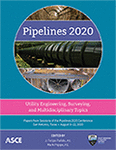Pipelines 2020
A Tried and True Method of Surge Control
Publication: Pipelines 2020
ABSTRACT
Surge Control is vital to the design of water transmission systems. If surge control methods are not properly implemented, surge pressures can have devastating effects on pumps, valves, pipe fittings, or pipelines—sometimes causing line breaks and service interruptions. A hydraulic transient can be caused by any number of events that cause the flow in the pipeline to be disrupted, including starting and stopping of a pump, an instantaneous closure of a delivery valve or a power failure at a pump station. When a reflected surge wave reaches the pump station, it must be dissipated through some open flow path to a lower pressure region. Failure to dissipate this reflected surge wave will cause a sudden pressure rise, due to the conversion of kinetic energy to potential energy. If the momentum energy and pressure energy of the reflected wave is not relieved, high surge pressures will result. There are several accepted approaches to surge control in the water industry. Many pump stations rely on check valves to prevent water from back-flowing through the pump, requiring an open path through a surge anticipator valve, pressure relief valve, or a lateral to a surge accumulator tank to dissipate the energy. The purpose of this paper is to provide the background and details for a distinct surge control methodology developed by Logan Kerr, chairman of the ASME’s Hydraulic Division Water Hammer Committee from 1933 to 1956. This methodology was later adopted and put into practice by Lee Freese in the late 1960s and implemented on dozens of water transmission systems across Texas. The main difference in this surge control philosophy centers around allowing the water to backspin through the pump after a power failure and using an accumulator system to slowly close the pump control valve after several cycles of the surge wave have passed through the system. This paper will provide additional details of the surge control methodology and its key components.
Get full access to this article
View all available purchase options and get full access to this chapter.
REFERENCES
1> Cooper, P., Martin, C.S., and O’Hern, T.J. (2016), History of the Fluids Engineering Division, ASME. Journal of Fluids Engineering, Volume 138, Issue 10, October 2016.
2> Karassik, Igor J., Krutzsch, William C., Fraser, Warren H., and Messina, Joseph P., Pump Handbook, 2nd Edition, 1986.
3> Stepanoff, A.J., Centrifugal and Axial Flow Pumps, 2nd Edition, 1957.
4> Wylie, E. Benjamin and Streeter, Victor L., Hydraulic Transients, 1982.
Information & Authors
Information
Published In
Pipelines 2020
Pages: 1 - 10
Editors: J. Felipe Pulido, OBG, Part of Ramboll and Mark Poppe, Brown and Caldwell
ISBN (Online): 978-0-7844-8321-3
Copyright
© 2020 American Society of Civil Engineers.
History
Published online: Aug 6, 2020
Published in print: Aug 6, 2020
Authors
Metrics & Citations
Metrics
Citations
Download citation
If you have the appropriate software installed, you can download article citation data to the citation manager of your choice. Simply select your manager software from the list below and click Download.
